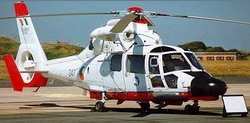Fri, Dec 01, 2006
 Applicability: Model SA 365
N, SA 365 N1, AS 365 N2, AS 365 N3, SA 365 C, SA 365 C1, SA 365 C2,
and SA 365 C3 helicopters, all serial numbers, if a main rotor head
(MRH) fitted with frequency adapters and frequency adapter bushes
is installed, as referenced below:
Applicability: Model SA 365
N, SA 365 N1, AS 365 N2, AS 365 N3, SA 365 C, SA 365 C1, SA 365 C2,
and SA 365 C3 helicopters, all serial numbers, if a main rotor head
(MRH) fitted with frequency adapters and frequency adapter bushes
is installed, as referenced below:
- pre MOD 0762C39 and used in hot climatic conditions and/or
tropical and damp atmosphere, or
- post Mod 0762C39.
The part numbers of the affected frequency adapters and
frequency adapter bushes are listed in paragraph 2.B.2.v and
paragraph 2.B.5 of Eurocopter AS 365 Alert Service Bulletin (ASB)
No. 62.00.24 and SA 365 ASB No. 65.45, as applicable.
Note 1: The use of a helicopter in tropical and
damp atmosphere is defined as follows: A helicopter operated in
climatic conditions with outside air temperatures from 28 degrees
centigrade upward combined with relative humidity from 75%
upward.
Note 2: The use of a helicopter in hot climatic
conditions is defined as follows: A helicopter operated in areas
with high solar radiation temperatures above 40 degrees
centigrade.
Requirement:
- A MRH fitted with frequency adapters pre MOD 0762C39 and
operated in hot climatic conditions and/or in tropical and damp
atmosphere: Modify the frequency adapters and frequency adapter
bushes per MOD 0762C39, in accordance with paragraphs 2.B.1, 2.B.2
and 2.B.3 of AS 365 ASB No. 62.00.24 and SA 365 ASB No. 65.45, as
applicable.
- A MRH fitted with frequency adapters post MOD 0762C39: Check
that the lockwire is in place and that the holes in the frequency
adapters and in the frequency adapter bushes are not blocked, in
accordance with paragraph 2.B.6 of AS 365 ASB No. 62.00.24 and SA
365 ASB No. 65.45, as applicable.
- If the lockwire is in place on the trailing edge of the
frequency adapter and if the four holes are not blocked, flights
may be resumed.
- If the lockwire is not in place, before further flight,
re-position the bush if it has turned, and fit the lockwire.
- If one hole or more is/are blocked, before further flight,
unblock the hole(s). After the effective date of this Directive, no
person may install any of the following equipment held as spares
and intended for use in hot climatic conditions and/or in tropical
and damp atmosphere:
-
- MRHs fitted with frequency adapters,
- Frequency adapter assemblies,
- Non-drilled frequency adapter bushes, on a helicopter as a
replacement part, unless it has been modified in accordance with
paragraph 2.B.2 or 2.B.4 or 2.B.5 of AS 365 ASB No. 62.00.24 and SA
365 ASB No. 65.45, as applicable.
Note: EASA Emergency AD 2006-0362-E refers.
Compliance:
- Within 110 flight hours after 2 December 2006.
- Within 10 flight hours after application of MOD 0762C39, or
within 10 flight hours after 2 December 2006, whichever occurs
later, and thereafter at intervals not to exceed 10 flight
hours.
This Airworthiness Directive becomes effective on 2 December
2006.
 Background: The EASA
received reports of deterioration and two reports of failure of
Starflex star arm ends. Such deterioration generated high-amplitude
vibrations in flight, compelling the pilot to carry out a
precautionary landing, in both cases. A failure of the Starflex
star arm end could make it impossible to control the helicopter.
The deteriorations are due to the strong effect of temperature on
the strength of the Starflex star arm end attachment.
Background: The EASA
received reports of deterioration and two reports of failure of
Starflex star arm ends. Such deterioration generated high-amplitude
vibrations in flight, compelling the pilot to carry out a
precautionary landing, in both cases. A failure of the Starflex
star arm end could make it impossible to control the helicopter.
The deteriorations are due to the strong effect of temperature on
the strength of the Starflex star arm end attachment.
More News
Aero Linx: Aviators Code Initiative (ACI) Innovative tools advancing aviation safety and offering a vision of excellence for aviators. The ACI materials are for use by aviation pra>[...]
Make Sure You NEVER Miss A New Story From Aero-News Network Do you ever feel like you never see posts from a certain person or page on Facebook or Instagram? Here’s how you c>[...]
From 2016 (YouTube Edition): Who You Gonna Call When You Have a Rocket Engine that Needs a Spacecraft? While at EAA AirVenture 2016, ANN CEO and Editor-In-Chief, Jim Campbell, sat >[...]
"In my opinion, if this isn't an excessive fine, I don't know what is... The odds are good that we're gonna be seeking review in the United States Supreme Court. So we gotta muster>[...]
Expedite Used by ATC when prompt compliance is required to avoid the development of an imminent situation. Expedite climb/descent normally indicates to a pilot that the approximate>[...]
 ANN's Daily Aero-Linx (04.30.25)
ANN's Daily Aero-Linx (04.30.25) ANN FAQ: Turn On Post Notifications
ANN FAQ: Turn On Post Notifications Classic Aero-TV: Agile Aeros Jeff Greason--Disruptive Aerospace Innovations
Classic Aero-TV: Agile Aeros Jeff Greason--Disruptive Aerospace Innovations Aero-News: Quote of the Day (04.30.25)
Aero-News: Quote of the Day (04.30.25) ANN's Daily Aero-Term (04.30.25): Expedite
ANN's Daily Aero-Term (04.30.25): Expedite




